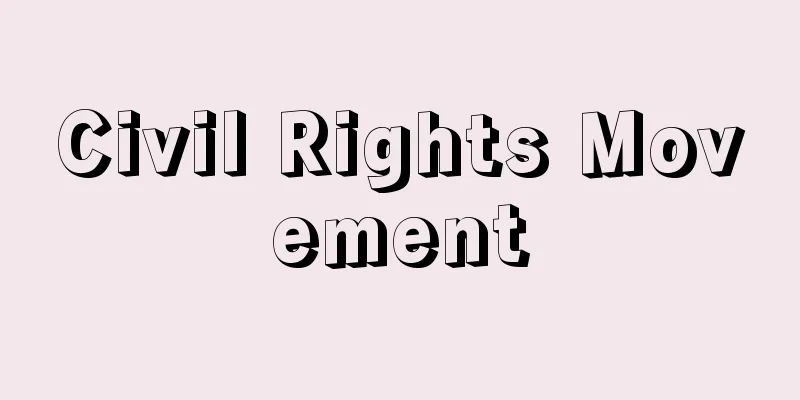Civil Rights Movement

|
A social movement that was launched by African Americans in the United States from the mid-1950s to the mid-1960s, calling for the elimination of discrimination, equality under the law, and freedom and rights as a citizen. After the end of the Civil War in 1865, slavery was abolished, and the 14th Amendment to the Constitution recognized African Americans as citizens and established "equality under the law," while the 15th Amendment prohibited restrictions on voting rights based on race. However, state laws such as those banning interracial marriage continued, and in the 1880s, systems that ran counter to the reforms that followed the Civil War were established in the South. Literacy tests and polling taxes were imposed to restrict voting rights, and violence, including lynchings, was rampant. In addition, the system of racial segregation known as the Jim Crow system spread to all facilities, from schools to cemeteries. In 1894, the Supreme Court ruled that segregation of facilities by race in Louisiana was constitutional as long as equivalent facilities were provided (Plessy decision). This "separate but equal" doctrine justified racial segregation for the next 60 years, even though in practice facilities for blacks were inferior to those for whites. Although the civil rights movement in the narrow sense began in the 1950s, African-American activism has a long history. The National Association for the Advancement of Colored People (NAACP), founded in 1909, placed emphasis on legal battles, and in a Supreme Court decision in 1938, it won the right to admit black students to graduate school at the University of Missouri. During World War II, dissatisfaction grew over the fact that people were subject to discrimination despite fulfilling their obligations as citizens, such as military service. In 1941, in response to a plan by A. Philip Randolph (1889-1979) to march on Washington, President F. D. Roosevelt issued an executive order banning racial segregation in munitions factories for the duration of the war. After the war, the NAACP shifted its focus to the racial integration of primary education institutions. In the 1954 Brown decision, which was a dispute over racial segregation in public elementary schools, the Supreme Court finally rejected the principle of "separate but equal" and declared racial segregation in schools unconstitutional. However, integration did not progress immediately after the decision, and southern white society fiercely resisted. In 1956, 101 southern federal representatives issued a declaration of opposition to racial integration and denounced the Supreme Court. In 1957, a crowd surrounded a high school in Little Rock, Arkansas, to prevent black students from enrolling, leading President Eisenhower to send in the military to protect the students. In 1962, the governor of Mississippi himself disrupted the enrollment process for black students at a state university on campus, leaving three people dead and many injured by the time the riots subsided. Thus, even though their lives were at risk, African Americans continued their movement. Along with the Brown decision, another catalyst for the rise of the civil rights movement was the bus boycott in Montgomery, Alabama. The boycott, which began with the arrest of Rosa Parks (1913-2005), a former secretary of the NAACP, for refusing to give up her bus seat to a white person, continued from 1955 to the end of 1956, and in a parallel lawsuit, the Supreme Court ruled that the city's racial segregation on buses was unconstitutional. The man who made his name as the boycott's leader was Martin Luther King, Jr. He advocated direct action based on nonviolence, and his ideas became a pillar of the civil rights movement. The Southern Christian Leadership Conference (SCLC), founded in 1957 with King as its chairman, is a central organization in the civil rights movement. Students also played a major role in the civil rights movement. In 1960, four black university students began a new form of direct action known as sit-ins in Greensboro, North Carolina. They sat in white-only sections of restaurants and continued to sit there until their orders were served. The sit-ins spread to other areas, and by the end of the year, 50,000 people had participated. Similar protests were also held in libraries, hotels, parks, and other places. In 1961, students from southern universities organized sit-ins and formed the Student Nonviolent Coordinating Committee (SNCC), which became a major player in the civil rights movement. The civil rights movement reached its climax with the March on Washington in August 1963, 100 years after the Emancipation Proclamation, and the passage of the Civil Rights Act of 1964 and the Voting Rights Act of 1965. 200,000 people participated in the march calling for the passage of the Civil Rights Act proposed by President Kennedy, and leaders including Randolph and King, who had proposed the March on Washington 23 years earlier, gave speeches in front of the Lincoln Memorial. The Civil Rights Act, enacted under the Johnson administration in July 1964, gave the federal government strong authority in the face of resistance from southern states and local governments that advocated states' rights. Its main provisions included the prohibition of literacy tests, strengthening the federal government's authority to promote racial integration in public facilities and educational institutions, and the prohibition of employment discrimination. However, even after the law was passed, there was fierce resistance to the exercise of voting rights, ranging from obstruction by government officials to murder. In the summer of 1964, the Freedom Summer movement was held in Mississippi, mainly among northern university students, to help voters register. Six activists were killed, but the federal government made no attempt to take any active measures to protect them or enable them to participate in politics. In March 1965, 25,000 people participated in a march from Selma to Montgomery, Alabama, calling for a more effective voting rights law. As a result, the Voting Rights Act was passed in August, giving federal officials the authority to monitor voter registration, and the voter turnout rate among African-Americans in the South subsequently increased. Furthermore, in 1967, the Supreme Court ruled that a state law banning interracial marriage was unconstitutional (Loving decision), and in 1968 the Civil Rights Act of 1968 was passed, banning discrimination in real estate transactions. As symbolized by the election of Mississippi's first black mayor in 1969, the number of African-American public officials increased from the late 1960s onwards due to rising voter turnout. In 1990, Virginia elected its first black governor in the United States, excluding the period immediately after the Civil War. Furthermore, the "affirmative action" policy based on the 1964 Civil Rights Act, which took historical discrimination into consideration in employment and admission selection, expanded opportunities for college admission and led to the creation of an elite class. Despite these great achievements, by the end of the 1960s, cracks had become evident among the organizations and leaders that led the civil rights movement over the means and goals of the movement. For example, SNCC advocated "Black Power," and drew a line at the nonviolence advocated by King and SCLC. The limitations of the Civil Rights Act and the Voting Rights Act also became apparent. In the North, there was no legal racial segregation or voting rights restrictions like those in the South, but de facto residential segregation and poverty in cities were serious problems. Frequent riots in Los Angeles and other cities in the late 1960s were a manifestation of this. The organizations also did not agree on the pursuit of measures to correct social inequality, such as poverty, beyond equality under the law. Furthermore, as the Vietnam War intensified, differences of opinion became clear regarding support for the Johnson administration, which backed the civil rights movement while deepening the US's military intervention, and its domestic and foreign policies. Thus, unified action became increasingly difficult, and the civil rights movement headed for a demise. [Yuuki Oda, August 21, 2017] "Poverty and Anger in the American South: 25 Years on the Road to the Civil Rights Movement" by Ann Moody, translated by Higuchi Emi (2008, Sairyusha)" ▽ "Foot Soldiers of the Civil Rights Movement: Diary of a White Female Student Who Struggled Against Black Racism" by Kita Miyuki (2016, Sairyusha)" ▽ "The History of Black People in America: New Edition" by Honda Sozo (Iwanami Shinsho)" ▽ "Martin King: A Search for Racial Equality and Humanity" by Tsujiuchi Kagamito and Nakajo Ken (Iwanami Junior Shinsho)" ▽ "Black Racism and the American Civil Rights Movement: A Record of the Battle of the Nameless" by James M. Vardaman, translated by Mizutani Hachiya (Shueisha Shinsho)" ▽ "The History of Black People in America: From the Slave Trade to President Obama" by Uesugi Shinobu (Chuko Shinsho)" [References] | | | | | | | | | | |Source: Shogakukan Encyclopedia Nipponica About Encyclopedia Nipponica Information | Legend |
|
アフリカ系アメリカ人により、1950年代なかばから1960年代なかばにアメリカで展開された、差別の撤廃と法の下の平等、市民としての自由と権利を求める社会運動。1865年の南北戦争終結後、奴隷制は廃止され、憲法修正第14条はアフリカ系アメリカ人を市民として認めるとともに「法の下の平等」を定め、第15条は人種による選挙権の制限を禁じた。しかし、異人種間の結婚禁止といった州法は存続し、1880年代には南北戦争後の改革に逆行する諸制度が南部では設けられた。選挙権制限のため識字テストや投票税が課され、リンチを含む暴力も横行した。またジム・クロウ制度と称される人種分離制度が、学校から墓地まであらゆる施設に広がった。1894年、最高裁判所は、ルイジアナ州における鉄道車両での分離に対して、同等の設備を設ければ、人種別に施設を分離すること自体は合憲であるという判決を下した(プレッシー判決)。この「分離すれども平等」理論は、以後60年にわたり、人種分離を正当化したが、実際は黒人用施設は白人用施設より劣悪であった。 狭義の公民権運動の始まりは1950年代であるが、アフリカ系アメリカ人の運動には長い歴史がある。1909年に設立された全国黒人向上協会(NAACP)は法廷闘争を重視し、1938年の最高裁判決では、ミズーリ州立大学大学院への黒人学生の入学を勝ち取った。第二次世界大戦中には、市民として兵役といった義務を果たしながらも差別にさらされることへの不満が高まった。1941年、A・フィリップ・ランドルフA. Philip Randolph(1889―1979)によるワシントンでのデモ行進計画に対し、F・D・ルーズベルト大統領は戦時中に限り軍需工場での人種分離を禁じる大統領令を発した。 戦後、NAACPは、初等教育機関の人種統合へと目標を転じた。公立小学校での人種分離を争点とした1954年のブラウン判決において、最高裁はついに「分離すれども平等」を否定し、学校での人種分離は違憲であると断じた。しかし、判決後すぐに統合が進んだわけではなく、南部白人社会は激しく抵抗した。1956年、南部の連邦議員101名は人種統合への反対宣言を表し、最高裁を非難した。1957年、アーカンソー州リトル・ロックの高校では、黒人生徒の入学を阻むため群衆が高校を取り囲み、生徒を守るためにアイゼンハワー大統領は軍隊を派遣するに至った。1962年、ミシシッピ州では、黒人学生の州立大学への入学手続を知事自身がキャンパスで妨害し、暴動収束までに3名が死亡し多数が負傷した。 このように、生命の危険にさらされながらも、アフリカ系アメリカ人は運動を続けた。ブラウン判決と並ぶ公民権運動の高まりの契機は、アラバマ州モントゴメリーでのバス・ボイコットである。白人にバスの席を譲らなかったことでNAACPの元秘書ローザ・パークスRosa Parks(1913―2005)が逮捕されたことに端を発するボイコットは1955年から1956年末まで続き、平行した訴訟では、同市のバスの人種隔離を違憲とする最高裁判決が下された。ボイコットの指導者として名を広めたのが、キング牧師である。キングは非暴力主義に基づく直接行動を唱え、その思想は広く公民権運動の柱となった。1957年にキングを議長として設立された南部キリスト教指導者会議(SCLC)は公民権運動の中心組織である。 学生も公民権運動に大きな役割を果たした。1960年、ノースカロライナ州グリーンズボロでは、4名の黒人大学生によりシット・インと称される新たな直接行動が始まった。飲食店の白人専用席に座り、注文が応じられるまで座り続けるというものである。座り込みは各地に広がり、同年末までに5万人が参加した。さらに、図書館、ホテル、公園などでも同様の抗議が行われた。1961年、シット・インの組織化を図り、南部諸大学の学生によって学生非暴力調整委員会(SNCC)が結成され、公民権運動の主要な担い手となった。 公民権運動は、奴隷解放宣言から100年後の1963年8月のワシントン大行進、1964年公民権法、1965年投票権法の成立をもって頂点を迎えた。ケネディ大統領が提案した公民権法の成立を求めた大行進には20万人が参加し、リンカーン記念堂前で、23年前にワシントン行進を提唱したランドルフやキングをはじめとする指導者たちが演説した。1964年7月にジョンソン政権下で成立した公民権法は、州権を唱える南部諸州や自治体の抵抗に対して、連邦政府に強い権限を与えた。おもな内容として、識字テスト禁止、公共施設や教育機関での人種統合を促進するための連邦政府の権限強化、雇用差別の禁止などがあげられる。 しかし、同法成立後も、選挙権行使に対しては役人による妨害から殺害まで激しい抵抗があった。1964年夏、ミシシッピ州では北部の大学生を中心に、有権者登録を助けるフリーダム・サマー運動が展開された。運動家6人が殺害されたが、連邦政府は運動家の保護や政治参加実現のための積極的措置をとろうとはしなかった。1965年3月、より実効性のある投票権法を求め実施されたアラバマ州セルマからモントゴメリーまでの行進には2万5000人が参加した。その結果8月に成立した投票権法は、連邦政府職員に有権者登録の監視権限を与え、その後、南部のアフリカ系アメリカ人の投票率は上昇した。 さらに、1967年には異人種間の結婚を禁じる州法が最高裁判所で違憲とされ(ラビング判決)、1968年には不動産取引における差別を禁じた1968年公民権法が成立した。1969年にミシシッピ州初の黒人市長が誕生したことが象徴するように、1960年代末以降、投票率の向上によってアフリカ系アメリカ人の公職者が増加した。1990年にはバージニア州で、南北戦争直後の時期を除けば全米でも初めての黒人知事が選出された。また、就職や入学選抜にあたり歴史的な差別を考慮するという、1964年の公民権法に基づく「積極的差別是正政策」(アファーマティブ・アクション)は大学への進学機会を広げ、エリート層の醸成へとつながった。 こうした大きな成果の一方で、1960年代末には、運動の手段や目標をめぐって、公民権運動を主導した諸団体や指導者の間のほころびも顕在化するようになった。たとえば、SNCCは「ブラック・パワー」を唱え、キングやSCLCが掲げた非暴力主義とは一線を画すようになった。公民権法や投票権法の限界もまたあらわになった。北部では、南部のような法律に基づく人種分離や投票権制限は存在しなかったものの、都市における居住地区の実質的分離や貧困問題が深刻であった。1960年代後半にロサンゼルスをはじめとする都市で暴動が頻発したことはその現れであった。法の下の平等に留まらない、貧困問題といった社会的な不平等の是正策の追求という点でも諸団体は一致しなかった。さらに、ベトナム戦争の激化に伴い、公民権運動の後ろ盾であると同時にアメリカの軍事介入を深めたジョンソン政権への支持、その内政と外交政策の評価についても見解の相違が鮮明になった。こうして、統一行動がしだいに困難になり、公民権運動は収束へ向かった。 [小田悠生 2017年8月21日] 『アン・ムーディー著、樋口映美訳『貧困と怒りのアメリカ南部――公民権運動への25年』(2008・彩流社)』▽『北美幸著『公民権運動の歩兵たち――黒人差別と闘った白人女子学生の日記』(2016・彩流社)』▽『本田創造著『アメリカ黒人の歴史――新版』(岩波新書)』▽『辻内鏡人・中條献著『キング牧師――人種の平等と人間愛を求めて』(岩波ジュニア新書)』▽『ジェームズ・M・バーダマン著、水谷八也訳『黒人差別とアメリカ公民権運動――名もなき人々の戦いの記録』(集英社新書)』▽『上杉忍著『アメリカ黒人の歴史――奴隷貿易からオバマ大統領まで』(中公新書)』 [参照項目] | | | | | | | | | | |出典 小学館 日本大百科全書(ニッポニカ)日本大百科全書(ニッポニカ)について 情報 | 凡例 |
<<: Suspension of civil rights
Recommend
Pravarasena I (English spelling)
…After the collapse of the Satavahana dynasty, th...
Ayase River
A river that flows south through eastern Saitama ...
Les Rougon‐Macquart
This is a series of works that is the masterpiece ...
Kurodani Shonin's words and phrases - Kurodani Shonin's words and phrases
A Buddhist book from the Kamakura period. 18 volum...
Gasur
…The present name is Yorghan Tepe. However, the s...
Hidekazu Okakura
…From 1951, he was in charge of the elementary co...
Mahayana (English spelling)
...These are scriptures such as the Prajnaparamit...
Tenyaku - Tenyaku
Miscellaneous taxes were temporarily levied in the...
Genetic modification - Idenshikumicae
DNA extracted from a different species is cut in a...
Melampyrum laxum (English spelling) Melampyrum laxum
… [Kei Yamazaki]. … *Some of the terminology that...
Matthias Erzberger
German politician. A member of the Catholic Cente...
Kushiro [city] - Kushiro
A city in eastern Hokkaido facing the Pacific Ocea...
Li Guangli - Li Guangli
A military commander of the Western Han Dynasty i...
Dye toning
...Dyeing was considered from the early days of f...
Government-run shipyard - Kan'eizosenjo
…Then, in 1856, the Mito Domain built a repair fa...









